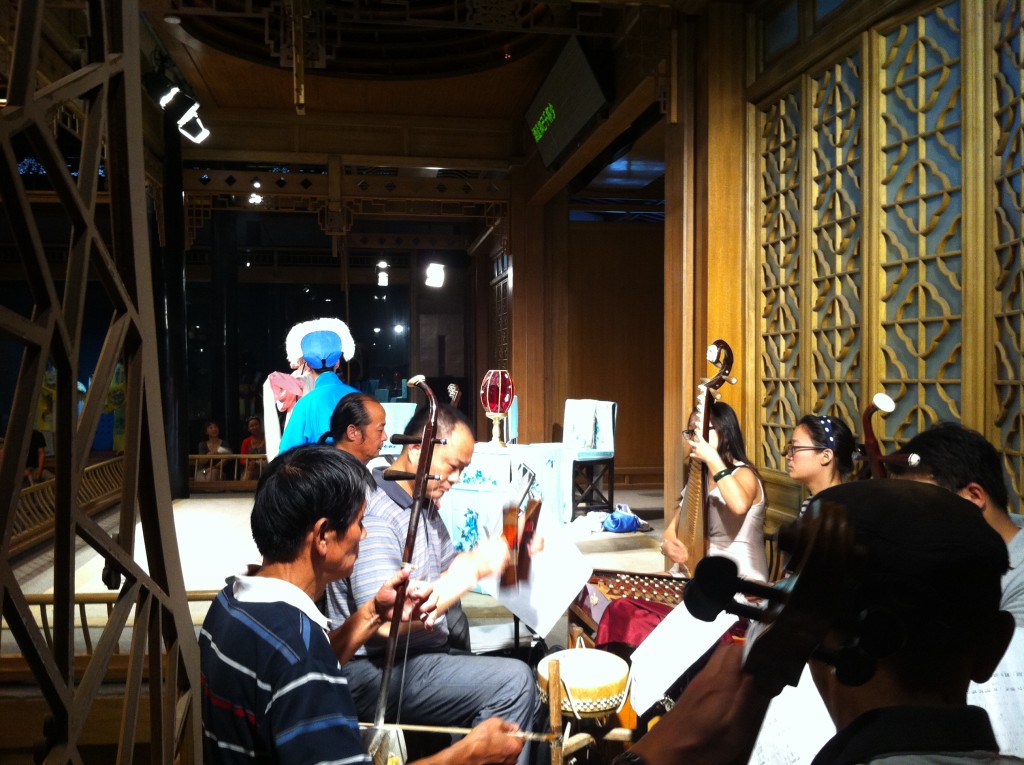The Kunqu Museum closed for remodeling in 2014 and at the date I am writing this (May 2015) has still not re-opened. What follows, therefore, describes it as it used to be.
The history of kunqu (sounds like “quinn chew”) goes back about 700 years, making it much older than the Peking Opera that many Westerners will have at least heard of. The kun in kunqu is the same as in Kunshan. Train travelers between Suzhou and Shanghai will recognize this as the stop halfway through their journey. It was there that this art form was born.
Suzhou’s Kunqu Museum is just a few minutes’ walk from Ping Jiang Lu, in the centre of the old town. It is a museum—more about that in a moment—but more importantly it is a performance space, where every Sunday afternoon (except in the summer and the coldest part of winter) you can see and hear world-class kunqu actors and musicians.
For 30 RMB (about US$5.00—clearly the museum receives subsidies from the government) you can sit in the tiny theatre and marvel at the art of these singing actors whose every movement—down to the last fingertip—is exquisitely precise. You won’t understand a word, but it doesn’t matter. Even most of the Chinese members of the audience need to read the lyrics on a very untraditional LED display over the stage, because the actors’ words are in ‘Suzhou hua’, the local Suzhou dialect. So I just focus on the sounds, and kunqu, to my ears, is much more pleasant than its northern cousin, Peking Opera.
Watch how the actors manage the impossibly long silk sleeves of their robes: one, two, three quick upward motions and suddenly the hands emerge, the sleeves arranged in neat folds on the wrists. Watch the hands—every motion deliberate and stylized, a total choreography. The comical characters sometimes display amazing acrobatics. Freed from trying to understand what’s going on, relax and enjoy how the actors move, and how they use their voices in ranges from low bass to a falsetto that I cannot even imagine reproducing.
I like to sit on the side near the musicians, where I can watch them play in perfect sync with the actors: cymbal, drum, dulcimer, flutes, and several stringed instruments including the erhu. All of them are wonderful, but I especially like the fellow who leads the group. With his right hand he uses a thin stick to strike a small drum whose head is very tight and hard, producing high-pitched punctuations at varying intervals. With his left hand he keeps tempo for the group by clapping two blocks of wood that are loosely connected with a silk ribbon. How he controls them—I have tried it myself, and failed miserably—I will never know. How he manages to do such different things with either hand, simultaneously, is truly impressive.
Performances begin at 2:00, and they open the door to the seating area at 1:30. Seats are limited so it’s best to arrive early. Feel free to bring snacks and drinks with you. The shows last about an hour, with two or three different pieces being performed in that time. Kunqu performances are never complete, because the stories are taken from very long works that would require many, many hours to stage in their entirety. So the pieces you see on a given Sunday are likely to be from two or three entirely different works.
Either before or after the performance, take the time to explore the museum’s exhibits showing some of the history of kunqu opera. The “portable” opera stage, designed to be taken into private homes for performances, will impress you. There are also vintage costumes and props on display and lots of vintage photos. When you exit the museum, turn right to find, next door, a small shop of CDs, DVDs, and postcards focusing on kunqu, pingtan, and other traditional musical forms. The lady in the shop speaks a bit of English and will help you make a good choice to start off your collection.
If you find yourself looking for a kunqu performance mid-week, midsummer, or mid-winter when the museum troupe is not working, there are several other places around Suzhou where kunqu can be found. These venues keep changing, but in general the quality of acting and singing is lower and the music is either recorded or consists of just one or two instruments. However, these performances may also include some pingtan, the Suzhou folk music, and may give you a chance to meet and speak with the performers.
How to Get There
The Kunqu Opera Museum
昆曲博物馆, kun1 qu1 bo2 wu4 guan3
Tel: 67273741
Take Line 1 on the subway to Xiangmen. Exit on the north side of Ganjiang Road and walk north for about 3 minutes on Cangjie Street. The second street leading off to the left (west) is Zhongzhangjia Xiang (中张家巷). The Kunqu Museum is at #14, about halfway between Cangjie Street and Ping Jiang Lu. If you would like to call ahead to confirm whether there will be a performance on the day you plan to go, you will need a Chinese speaker to help you.



